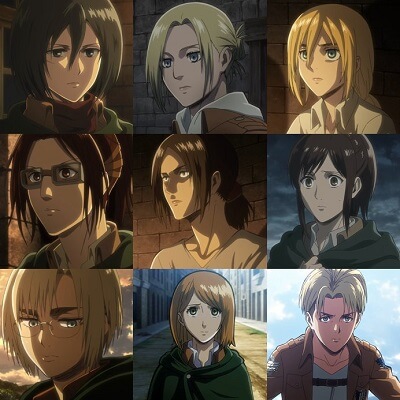Since the premiere of the first season in 2013, Attack on Titan has become a cultural phenomenon. You don’t even have to be a fan of survival horror to be enthralled by its complex characters, gruesome yet compelling world, or cascade of plot revelations.
However, one aspect of Attack on Titan popularity that is often overlooked is its appeal to women. This brutal, seemingly dude-centric series has a sizable female fanbase, who frequently praise its complex and realistic female cast.
Attack on Titan joins other shonen megahits like Fullmetal Alchemist and Tokyo Ghoul in attracting female fans by depicting a world in which women can be as interesting and powerful as men, but I believe Attack on Titan goes a step further than its contemporaries due to the roles its female characters play in the story.
While the other two shows have a lot of interesting and relatable female characters, they are mostly defined by their proximity to men: as sisters, maternal figures, and love interests. Women in Attack on Titan frequently fill roles that men could just as easily fill, with some even serving as stand-in protagonists when Eren is absent.
Attack on Titan also writes women in a similar manner to its men, with arcs that could be assigned to either gender. That’s not to say that this approach is always correct; sometimes it’s more useful to demonstrate how gendered expectations shape our life experiences, problems, and perspectives, especially in fiction set in real-world settings. However, fantasy does not have to adhere to those guidelines, and Attack on Titan does not. ODM gear maneuvering values speed, agility, balance, and reflexes over brute strength, as do the military’s hand-to-hand combat techniques, which pit women and men equally.
This, combined with the use of lower body muscles rather than upper body muscles to control the equipment, gives women an equal footing with men as soldiers. People of all genders appear to have equal(ly low) chances of surviving in Titan’s cruel yet beautiful world.
Of course, none of this implies that the female characters in Attack on Titan are perfect. They all have their ups and downs, and different aspects of their personalities appeal to different people. These are just a few of the female characters in Attack on Titan, whose stories both subvert and reinforce stereotypes.
Mikasa Ackerman
Mikasa is the most talked about and controversial member of the show’s female cast. She is the main character in the first part of the story, which is about Eren’s childhood in Shiganshina and his enrollment in the Cadet Corps. She is a member of the central “Shiganshina Trio,” along with Eren and Armin. Mikasa is the most powerful fighter in the group, towering over the other boys in terms of physical prowess and Titan kills. That has always been a key component of her “girl power” appeal.
The downside is that Mikasa lacks motivation and personality aside from her desire to protect Eren, her last remaining family member (and possibly more) after losing both sets of parents. The Shiganshina trio is completely reliant on one another, but Eren has a vendetta to kill every titan and Armin longs to see the outside world. Mikasa is driven solely by the desire to keep Eren alive. That’s a frustratingly common character trait for tough female characters in action series, and it’s also unrelatable for most women; even the most boy-crazy girls have other interests and relationships that matter to them.
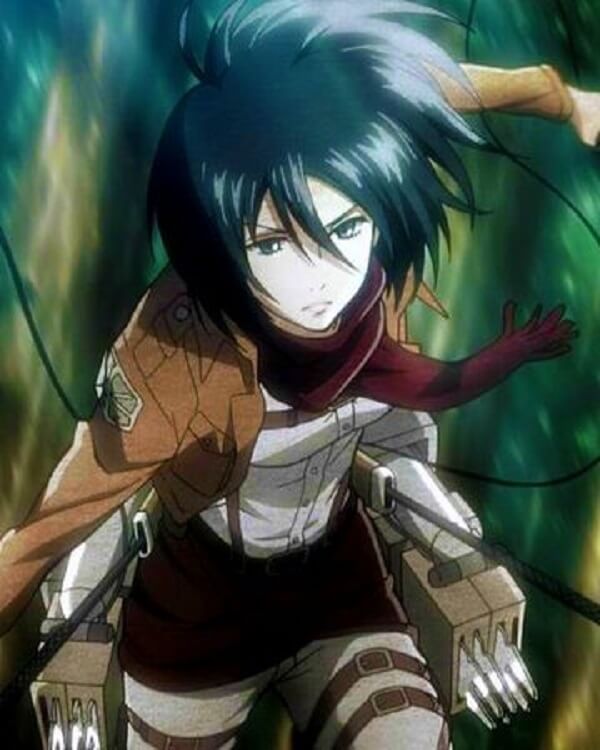
However, I believe that Attack on Titan justifies this character choice for two reasons. For one thing, given everything Mikasa has been through, it’s psychologically realistic. Mikasa didn’t have much of a life until Eren joined it in the anime, manga, and companion light novel Lost Girls.
She grew up on a remote mountain farm, her only contact with the outside world being doctor visits from Grisha Yeager. When Grisha’s son Eren assists her in killing the kidnappers who murdered her parents in order to sell her into slavery, and the Yeagers take her in, he remains her lifeline in a world she sees as empty and cruel. Even if Mikasa quickly gains physical strength over Eren, it’s easy to see how he’s come to define her world emotionally.
Mikasa is far from the only character in Attack on Titan who exhibits this level of codependence. Further down this list, there’s another female character with a similar single-minded focus on protecting another woman. The brutal world of Attack on Titan, where anyone can die and anything can be destroyed at any time, often drives people to cling to whoever will keep them going.
Most importantly, Mikasa is not the story’s only significant female character. One advantage of having a cast full of women is that it’s acceptable to write one or two characters who fit into more traditional roles. The problem stems from a lack of women, because the presence of one stereotype can easily imply that that’s how all women should be.
Mikasa’s character clearly has her own issues wrapped up in her complicated history of traumatic survival.
Also Read: Tammy Slaton, Angel Adoree
Sasha Braus
Sasha’s role in the story is to play the “everygirl” and provide comic relief. She, like Connie and Jean, gives us a glimpse into the lives of “regular people” inside the walls, those without special abilities or destinies.
These characters lack valuable personality traits such as Armin’s super-intelligence, Mikasa’s super-strength, or Eren’s indomitable spirit. They’ve come to show the audience where the majority of them would be in this desolate world. Sasha’s people, in particular, struggled for resources as hunters in the wilderness and are now at the mercy of Titans as mankind’s territory shrinks and they are forced to live in cooperation with the greater populace.
Sasha’s decision to join the military is purely pragmatic, a way for her to do her village proud and potentially increase their chances of survival.
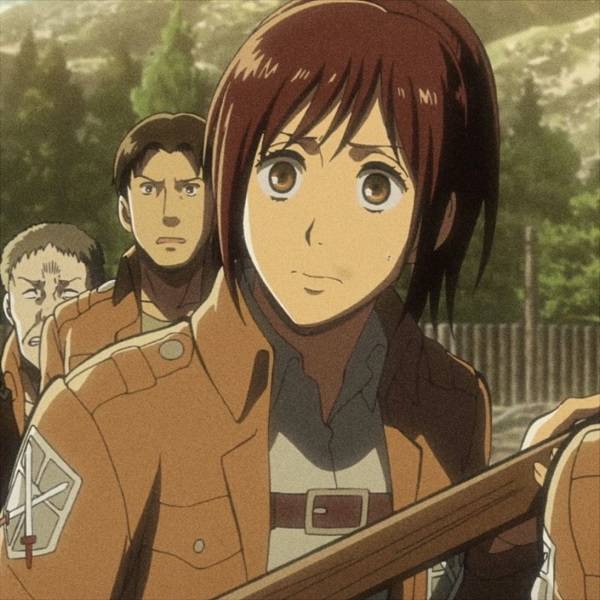
Attack on Titan hasn’t done much with Sasha yet, but her brief appearances are always intriguing. For a while, the famous “Potato Girl” became a joke due to a few moments of comic relief early in the series. Season two reveals that this was more than just a joke.
Anime is full of cute girls with enigmaticly large appetites, but Attack on Titan explains that Sasha grew up poor and frequently struggled to find food. She had to learn not to waste food by scarfing it down quickly before being forced to share it.
Even in the trainee corps, where she has plenty of food, old habits die hard, reflecting who she was even as she tries to hide her backwoods accent. Sasha may not be a codependent on other characters or a traumatized warrior, but growing up in this desolate world has had a negative impact on her.
As the plot progresses, Sasha remains the most entertaining and fascinating of Attack on Titan’s “everyman” characters, as she learns the importance of fighting to help others rather than just hunting for one’s own survival.
Her story exemplifies what makes Attack on Titan’s character writing so compelling. Titan’s cast, whether male or female, is made up of multi-faceted characters whose lives reflect the complexities of the world in which they grew up.
Annie Leonheart
Annie is the first of Attack on Titan’s villainous Titan shifter trio to be unmasked, consisting of her, Reiner, and Bertolt. In the final third of the first season, she transforms into the Female Titan, becoming the Big Bad of that arc for the rest of the characters.
At this point, we don’t know what the Titan shifters’ mission is, but we do know that these characters hold the key to many of the world’s mysteries in Attack on Titan. Before that, Annie is just another 104th Trainee Corps member: a stoic, mysterious, but strong and cunning young lady who seems to make sense only to Armin.
She teaches Eren a smarter way to defeat human opponents, based on using their opponent’s strength against them, and she warns him not to believe everything the Cadet Corps teaches him, from tactics to ideology. She’s also the only character who joins the Military Police instead of the Survey Corps after graduation, which keeps her out of the spotlight until her titan form appears, at which point her like-minded bond with Armin is explored.
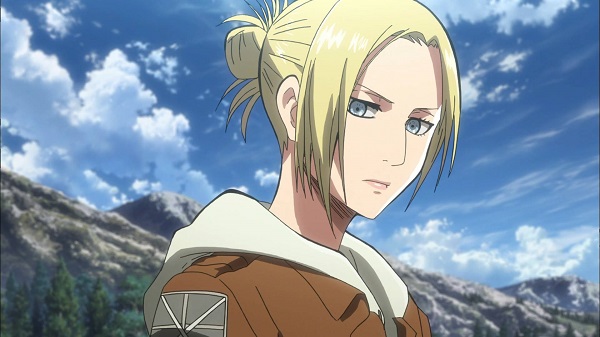
We eventually learn that Annie had a difficult childhood. She trained for her “mission” every day, without any creature comforts. While she appears to be close to her father, he also pushed her to prioritize her mission over all else.
As Annie investigates the disappearance of a local heiress in Lost Girls, we see the consequences of this. Annie doesn’t seem to know how to have fun, so she’s perplexed by those around her who do. Annie’s roommate enjoys going out dancing and partying in her spare time, but she doesn’t see the appeal. All she can think about is advancing in the police force until the day comes when she will be able to complete her mission.
In other words, Annie has the same singular focus as Mikasa, but she is focused on an abstract goal rather than another person. The same is true of Reiner and Bertolt, but with the Lost Girls novel, we get a glimpse into Annie’s mind that we haven’t had with either of them thus far.
All three members of the Titan shifter trio demonstrate the tragedy of children who are never allowed to be children, instead being forced to shoulder enormous adult burdens before they are ready. If you’re only an anime fan, Lost Girls is a book you should read.
Historia and Ymir
Ymir may be even more enigmatic than Annie. We know she’s a Titan Shifter, but we’re not sure how she got those abilities. It’s unclear where she stands in relation to the larger battle for humanity’s survival. She does, however, have a very clear motivation: she wants to protect Krista Lenz, whose real name has been revealed as Historia, the abandoned, illegitimate daughter of a powerful noble.
Until now, Historia and Ymir have been defined by their relationship with one another. That makes sense; having an author-confirmed lesbian relationship in a popular shonen series is pretty groundbreaking. The girls even yell about getting married to each other!
The anime hasn’t done much with that relationship yet, but Ymir and Historia are about to become much bigger characters in the story, both as individuals and in their relationship. It’s important to remember Ymir’s power and Historia’s lineage as the plot progresses.
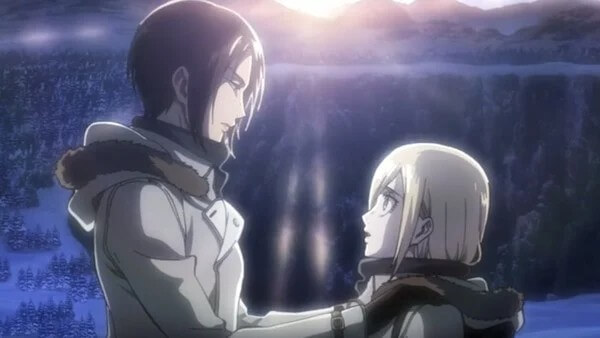
So far, both girls exhibit the same type of codependence that we’ll see throughout the Attack on Titan cast. Ymir is a closed-off and gloomy character, but she has always had a soft spot for Historia. That may appear perplexing given that “Krista” is the polar opposite of Ymir in personality and demeanor.
However, as Historia sheds her alias, we get to see more of the “real” her emerge and shed some light on what they see in one another. It’s already beginning to show in episode 31, when Historia shows great determination and bravery in standing up for Ymir. As season two progresses, their mutual codependence and strong love for one another will become clearer.
You may also read: Giyu Tomioka, Kanao Tsuyuri, Inosuke Hashibira
